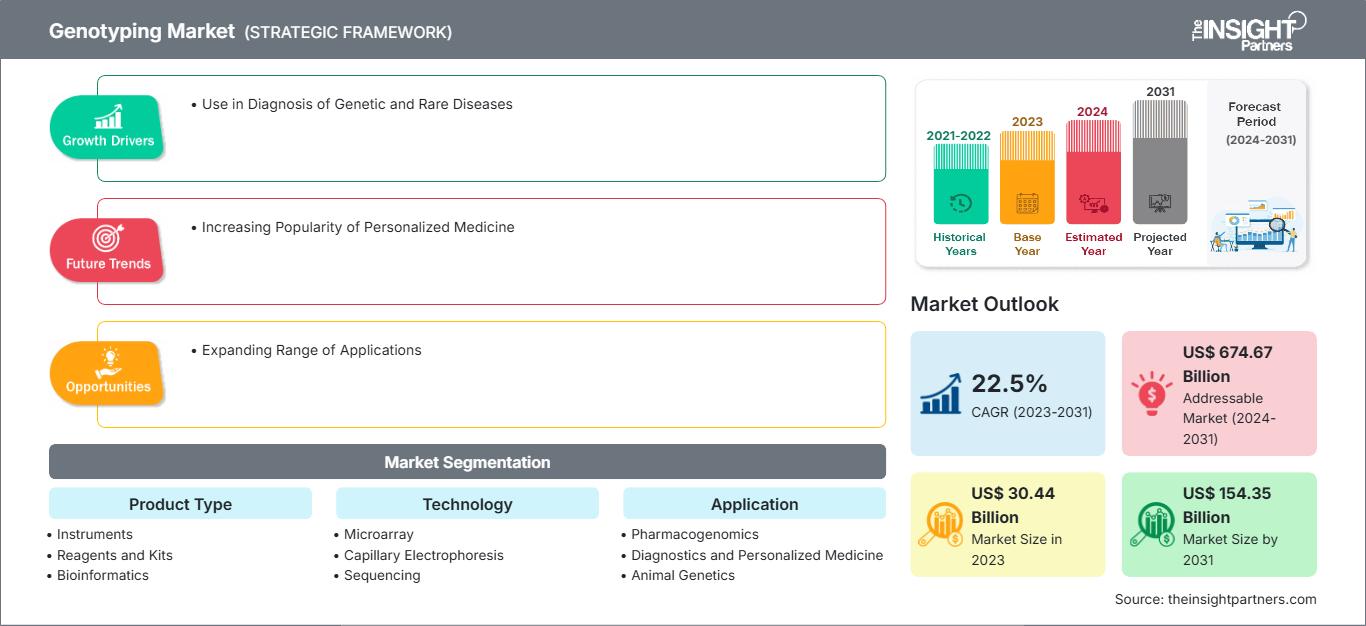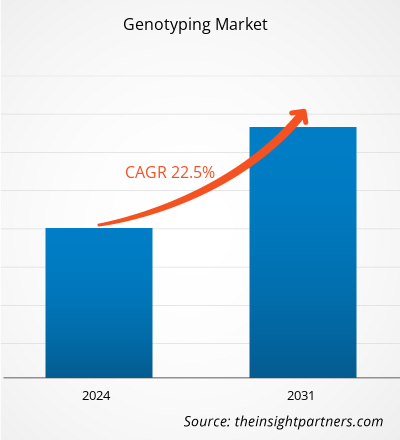ジェノタイピング市場規模は、2023年の304.4億米ドルから2031年には1,543.5億米ドルに達すると予測されています。市場は2023年から2031年にかけて22.5%のCAGRで成長すると予想されています。認知度向上のための取り組みやキャンペーンの拡大に伴い、パーソナライズ医療、農業、動物育種など、ジェノタイピングの多様な用途が市場の主要なトレンドであり続けるでしょう。
ジェノタイピング市場分析
次世代シーケンシングやマイクロアレイ解析などのハイスループットジェノタイピング技術の開発は、ジェノタイピング市場に利益をもたらしています。その後、作物の収穫量向上、耐病性作物の開発、家畜生産の強化を目的とした農業や動物育種におけるジェノタイピングの利用が増加しており、これがジェノタイピング市場の成長を促進する主要な要因の1つとなっています。ゲノミクス、遺伝学、および関連分野における進行中の研究開発活動も、新しい遺伝子マーカーの発見や疾患との関連の発見につながり、市場の発展に貢献しています。
ジェノタイピング市場の概要
インドは、人口の多さ、出生率の高さ、および一部のコミュニティにおける近親婚の選好により、遺伝性疾患の有病率が比較的高い国です。疾患の変異スペクトルを理解することで、こうした疾患の負担を軽減することを目指して、ヒト遺伝学、ゲノム解析、および精密医療に関する研究開発 (R&D) が行われています。これらの R&D プログラムは、出生前および新生児スクリーニング プログラムの実装、遺伝性疾患の費用対効果の高い診断方法とこれらの疾患に対する手頃な治療法の開発、および個別化医療レジメンの作成に重点を置いています。
インドでは、がんなどの遺伝性疾患が蔓延しています。 WHOによると、2022年のインドでは約141万人ががんに苦しんでいました。「国家がん登録プログラムに基づくインド11地域における乳がん生存率」という記事では、乳がんがインドで最も一般的ながんであるとされており、女性のがん症例全体の約28.2%を占めています。2022年には、女性で約216,108件の乳がん症例が報告されました。
インドにおけるゲノム研究の主なプログラムと取り組みは以下のとおりです。
- DBT –遺伝性疾患の独自の管理方法(UMMID)イニシアチブ
- GenomeIndia
- インドの特定の近親婚集団のヒトマイクロバイオームイニシアチブ
- 単一遺伝子疾患に関するプログラム
- National Genomics Core
したがって、ゲノム研究におけるプログラムとイニシアチブの急増は、今後数年間でインドのジェノタイピング市場の成長に大きな機会をもたらすでしょう。
要件に合わせてレポートをカスタマイズ
レポートの一部、国レベルの分析、Excelデータパックなどを含め、スタートアップ&大学向けに特別オファーや割引もご利用いただけます(無償)
ジェノタイピング市場: 戦略的洞察

- このレポートの主要な市場動向を入手してください。この無料サンプルには、市場動向から見積もりや予測に至るまでのデータ分析が含まれます。
レポートの一部、国レベルの分析、Excelデータパックなどを含め、スタートアップ&大学向けに特別オファーや割引もご利用いただけます(無償)
ジェノタイピング市場: 戦略的洞察

- このレポートの主要な市場動向を入手してください。この無料サンプルには、市場動向から見積もりや予測に至るまでのデータ分析が含まれます。
ジェノタイピング市場の推進要因と機会
遺伝性疾患および希少疾患の診断における使用が市場を後押しする
世界保健機関(WHO)によると、2050年までに約3,500万人の新たな癌症例が発生する可能性があり、これは2022年の対応する2,000万人症例から77%の増加となります。2022年、アルツハイマー病協会は、米国におけるアルツハイマー病患者の数が急増していると述べました。この病気は、あらゆる年齢層の600万人以上のアメリカ人に影響を与えています。協会の推計によると、2022年の時点で65歳以上の650万人のアメリカ人がアルツハイマー病を患っており、この人口の73%が75歳以上でした。Journal of Health Monitoringに掲載された研究によると、世界中で最大3億人が希少疾患に苦しんでいます。個々の疾患はまれですが、全体として世界の医療システムにとって重大な課題を提起しています。
がん、アルツハイマー病、希少疾患は臨床的に特定するのが難しいため、集団における診断検査の基盤としてジェノタイピングが重要な役割を果たしています。ジェノタイピングで得られたDNA配列をサンプルまたは参照配列と比較することで、変異を特定できます。ジェノタイピングは、集団内における遺伝子相補における小さな変異である一塩基多型(SNP)の検出にも用いられます。ヒトゲノムには約6億6000万のSNPがあり、最も広範囲にわたる遺伝子変異となっています。さらに、健康な集団と病気の集団の多型を比較することにより、ゲノムワイド関連研究(GWAS)は一般的な病気とSNPの関連性を明らかにすることができます。GWASは、推定原因を見つけることで、疾患の根底にある分子メカニズムを解明することができます。SNPは、細菌などの単細胞生物にも存在します。 SNPジェノタイピングは微生物分離株を区別することができ、抗生物質耐性株の特定にも応用できます。SNPベースの株検出は、医薬品および臨床分析のそれぞれに大きな影響を与え、感染症の疫学研究にも利用されています。
このように、遺伝性疾患や希少疾患の診断におけるジェノタイピング技術の利用は、ジェノタイピング市場を活性化させます。
応用範囲の拡大が市場機会を提供
ジェノタイピングは、診断研究、薬理ゲノム学、農業バイオテクノロジーにおける潜在的な応用を秘めています。さらに、この技術は、植物育種、法医学、環境試験など、さまざまな検査手順に適しています。製薬会社は、多遺伝子リスクスコア、患者の健康情報にリンクされた膨大な遺伝子データベース、臨床試験参加者の配列データなどの進歩から利益を得ています。製薬会社の協会である Industry Pharmacogenomics Working Group (I-PWG) は、薬理ゲノム研究に積極的に関与しています。I-PWG は、毎年多数の臨床試験を実施し、プロトコルの一部として被験者の DNA サンプルを収集する 26 社の会員企業で構成されています。臨床薬理ゲノム学に重点を置く I-PWG は、今後数年間で製薬会社に機会を生み出すことを目指しています。臨床薬理ゲノム学は、腫瘍学研究で最も頻繁に使用されているほか、希少疾患、免疫学、心臓病学など、腫瘍学以外の治療領域で行われる PGx 研究にも使用されています。臨床試験サンプルの NGS を含むより包括的な研究により、試験参加者の精巧なゲノム評価が可能になり、一般的な遺伝子変異とまれな遺伝子変異の両方が明らかになります。PGx には、ゲノムレベルの薬物/異物の影響、薬物反応と疾患感受性、および遺伝子型/表現型の関係を決定するための多型の違いの研究が含まれます。したがって、様々な研究分野でジェノタイピングの採用が広がれば、最終的にはこれらの技術の需要が高まり、今後数年間で市場に大きなチャンスが生まれるでしょう。
ジェノタイピング市場レポートのセグメンテーション分析
ジェノタイピング市場分析の導出に貢献した主要なセグメントは、製品タイプ、技術、アプリケーション、エンドユーザーです。
- 製品タイプに基づいて、ジェノタイピング市場は、機器、試薬とキット、バイオインフォマティクス、およびジェノタイピングサービスに分かれています。試薬とキットのセグメントは、2023年に最大の市場シェアを占めました。
- 技術に基づいて、ジェノタイピング市場は、マイクロアレイ、キャピラリー電気泳動、シーケンシング、マトリックス支援レーザー脱離イオン化飛行時間(MALDI-ToF)質量分析、ポリメラーゼ連鎖反応(PCR)などに分かれています。 PCRセグメントは2023年に最大の市場シェアを占めました。
- 用途別に見ると、ジェノタイピング市場は、薬理ゲノミクス、診断および個別化医療、動物遺伝学、農業バイオテクノロジー、その他に分類されています。診断および個別化医療セグメントは、2023年に最大の市場シェアを占めました。
- エンドユーザー別に見ると、ジェノタイピング市場は、製薬およびバイオ医薬品企業、診断および研究ラボ、学術機関、その他に分類されています。製薬およびバイオ医薬品企業セグメントは、2023年に最大の市場シェアを占めました。
地域別のジェノタイピング市場シェア分析
ジェノタイピング市場レポートの地理的範囲は、主に北米、アジア太平洋、ヨーロッパ、中東およびアフリカの5つの地域に分かれています。 2023年には北米が市場を牽引しました。先進技術を搭載した製品やソリューションの採用増加、そして研究開発活動の急増が、この地域のジェノタイピング市場を後押しする要因となっています。さらに、「All of Us Research Program」などの政府主導のプログラム、様々なゲノムコミュニティによる取り組み、そしてジェノタイピングサービスへの認知度の高まりが、北米全域での市場拡大を牽引しています。アジア太平洋地域は、予測期間中に最も高いCAGRを記録すると予想されています。
ジェノタイピング市場の地域別分析
予測期間全体を通してジェノタイピング市場に影響を与える地域的な傾向と要因については、The Insight Partnersのアナリストが詳細に解説しています。このセクションでは、北米、ヨーロッパ、アジア太平洋、中東・アフリカ、中南米におけるジェノタイピング市場のセグメントと地域についても解説しています。
ジェノタイピング市場レポートの範囲
| レポート属性 | 詳細 |
|---|---|
| の市場規模 2023 | US$ 30.44 Billion |
| 市場規模別 2031 | US$ 154.35 Billion |
| 世界的なCAGR (2023 - 2031) | 22.5% |
| 過去データ | 2021-2022 |
| 予測期間 | 2024-2031 |
| 対象セグメント |
By 製品タイプ
|
| 対象地域と国 | 北米
|
| 市場リーダーと主要企業の概要 |
|
ジェノタイピング市場のプレーヤー密度:ビジネスダイナミクスへの影響を理解する
ジェノタイピング市場は、消費者の嗜好の変化、技術の進歩、製品の利点に対する認知度の高まりといった要因によるエンドユーザーの需要増加に牽引され、急速に成長しています。需要の増加に伴い、企業は提供内容の拡大、消費者ニーズへの対応のための革新、そして新たなトレンドの活用を進めており、これが市場の成長をさらに加速させています。

- 入手 ジェノタイピング市場 主要プレーヤーの概要
ジェノタイピング市場のニュースと最近の開発
ジェノタイピング市場は、一次調査と二次調査後の定性的および定量的データを収集することで評価されます。これには、重要な企業の出版物、関連データ、データベースが含まれます。市場の開発のいくつかを以下に示します。
- Standard BioTools Inc. は、X9 ハイスループット ゲノミクス システムに NGS ライブラリ調製機能を追加しました。このリリースにより、顧客は初めて単一のベンチトップ システムでリアルタイム PCR と次世代シーケンス (NGS) ライブラリ調製アプリケーションを実行し、スクリーニングによる発見をサポートできるようになりました。(出典: Standard BioTools Inc.、企業 Web サイト、2023 年 5 月)
- Bio-Rad Laboratories, Inc. は、基礎研究、トランスレーショナル リサーチ、プロセス開発、品質管理における PCR アプリケーションをサポートするように設計された PTC Tempo 48/48 および PTC Tempo 384 サーマル サイクラーをリリースしました。 PTC Tempo 48/48 および PTC Tempo 384 サーマル サイクラーは、Bio-Rad の従来型 PCR サーマル サイクラーのポートフォリオに新たに追加された製品です。 (出典:Bio-Rad Laboratories, Inc.、企業ウェブサイト、2022年9月)
ジェノタイピング市場レポートの対象範囲と成果物
「ジェノタイピング市場規模と予測(2021~2031年)」レポートは、以下の分野を網羅した詳細な市場分析を提供します。
- 調査対象となるすべての主要市場セグメントにおける、世界、地域、国レベルでのジェノタイピング市場規模と予測
- ジェノタイピング市場の動向、推進要因、制約要因、主要な機会などの市場動向
- 詳細なPEST/ポーターの5つの力とSWOT分析
- 主要な市場動向、世界および地域の枠組み、主要プレーヤー、規制、最近の市場動向を網羅したジェノタイピング市場分析
- 市場集中、ヒートマップ分析、主要プレーヤー、ジェノタイピング市場の最近の動向を網羅した業界展望と競争分析市場
- 詳細な企業プロフィール
- 過去2年間の分析、基準年、CAGRによる予測(7年間)
- PEST分析とSWOT分析
- 市場規模価値/数量 - 世界、地域、国
- 業界と競争環境
- Excel データセット
最新レポート
お客様の声
購入理由
- 情報に基づいた意思決定
- 市場動向の理解
- 競合分析
- 顧客インサイト
- 市場予測
- リスク軽減
- 戦略計画
- 投資の正当性
- 新興市場の特定
- マーケティング戦略の強化
- 業務効率の向上
- 規制動向への対応




















 無料サンプルを入手 - ジェノタイピング市場
無料サンプルを入手 - ジェノタイピング市場